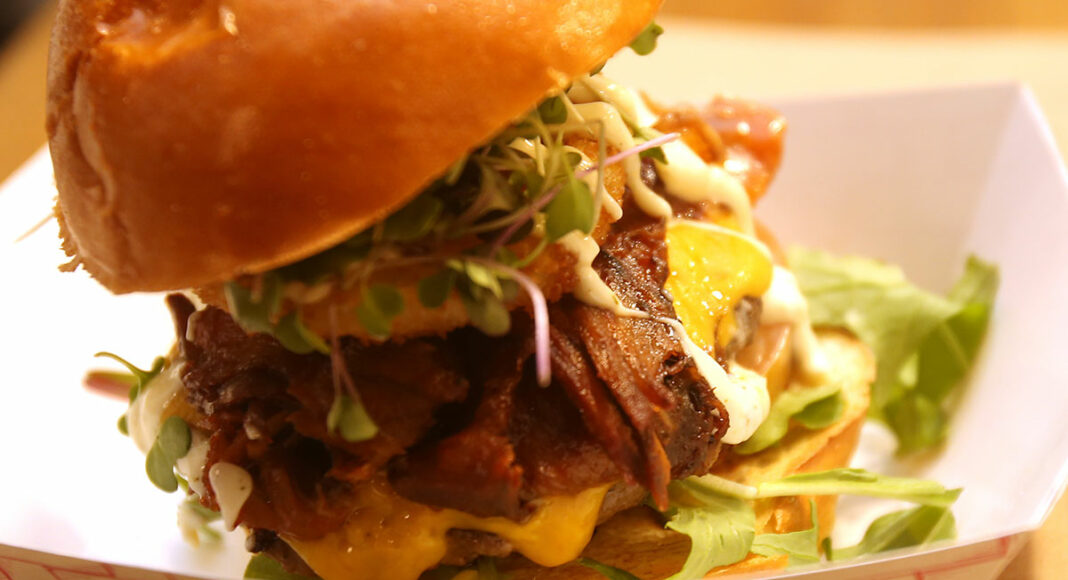On the short list of foods people love, the burger ranks high. How high?
Check the menu at restaurants the world over, and you’ll find a burger with fries. Hot grilled patty with tomato, onion, lettuce, melted cheese on a soft bun. Heaven! In Santa Cruz, not only are there countless menus offering burgers, but some places are dedicated entirely to the all-American treat, most recently Belly Goat Burgers at Abbott Square Market.
A glance at the menu says it all. This place is all about pace-setting burgers, burgers like you wish your mother had made. No generic beef on this menu. The hamburgers at Belly Goat Burger begin at Markegard Family Grass-Fed ranch a few miles up Highway 1, where grass-fed beef are raised with an ocean view. The burgers on the Belly Goat menu are not only handcrafted, they are curated and designed by the culinary brain of chef and consultant Anthony Kresge. Kresge’s handprint is still visible in the specialty burgers he started up during his stints at Shadowbrook, Sotola, and Vinocruz.
No burger at Belly Goat is ordinary. Layered between two buns and piled high with fillings like smoked Rogue blue cheese with bacon jam. Barbecued pork belly and kimchi. Pickled jalapeño slaw, poblano relish and smoked cheddar. You get the picture. Belly Goat is a showcase for the 21st century hamburger, reconstructed to deliver acres of flavor per bite while still appealing to that primal good ole American hamburger craving.
“I’m a menu consultant, and until I opened my own business Reef Dog Deli on Dec. 23, 2020, I did a lot of projects,” Kresge says. On both sides of the hill, Kresge applied his culinary and business savvy to menu design in corporate and restaurant settings. Concept development was his special skill, and Belly Goat Burger was a key project.
“Essentially with this kind of food, we’re going back to the beginning,” he says. “We have to ask ourselves how to reinvent food beyond the white tablecloth legacy, by examining the basics of how to-go food really started.”
In thinking about how we eat now, and in the future, Kresge looked back at European street food history.
“It was a survival skill, the old-world concept of to-go foods. Look at delis in Europe, or in large urban centers,” he says. “There’s no seating, people are moving fast, so you don’t want to complicate it. If I could produce something as delicious as any fine dining, yet make it grab and go, then I would have the next thing.”
What’s the enduring appeal of the hamburger? “Ah, the hamburger,” he says with a sigh. “It’s an American classic. It keeps on showing up because it’s not broken. It’s everywhere. I look in my grandmother’s cookbook and there’s always a hamburger something. Then McDonald’s and Burger King took over. But that was fast food.”
Borrowing from fast food while beefing it up, Kresge and colleagues asked themselves: “How do we keep it a classic, but make it better?” One answer was sourcing grass-fed beef. “In order to add a burger to serious menus, we had to blow people’s minds. And that’s where the additions like bacon jam and caramelized onions started coming in. For me personally, I have always asked, ‘What does it taste like when I take that first bite?’” he says. “It has to be there in the first bite. And that means using great ingredients.”
Starting up Belly Goat before he decided to pivot and open his own business, Reef Dog Deli, Kresge and his team worked smarter, not harder. “We’re making fries, but we’re taking pre-cut Idahos, then finish them, turn them into garlic fries right there in the kitchen. We use garlic confit, so it takes the heat out of the garlic. It’s a sweeter bit of garlic.”
The industry standard of a fine commercial hamburger was In-N-Out, Kresge contends: “The principal baseline, using good buns, and good fries.”
But Kresge has watched most franchise burgers get smaller over time. “For us organic chefs, the last thing we want is to diminish the patron’s experience. We want to create something that produces a ‘Wow! I’m coming back’ response. We want to make a handcrafted burger that people will love.”
Find offerings from Belly Goat and many more local restaurants in Santa Cruz Burger Week, running Feb. 24 – March 2.














The first location of Yaw’s Top Notch Restaurant opened on July 24, 1926. It began as a small 14-stool restaurant on NE 41st Avenue just off Sandy Blvd in Hollywood. Yaw’s was famous for its burgers, gravy fries and berry tarts. This building was expanded four times in its first four years. Yaw’s would grow to become America’s Drive-In and “The House that Hamburger Built.”
One of Oregon’s longtime eateries, Yaw’s Top Notch, was very popular and it served several generations of Portlanders. W.P. and Grace Yaw opened Yaw’s Top Notch Restaurant in 1926. Soon thereafter Englebert Franz of Portland’s Franz Bakery developed the very first hamburger bun at the request of Yaw’s Restaurant.